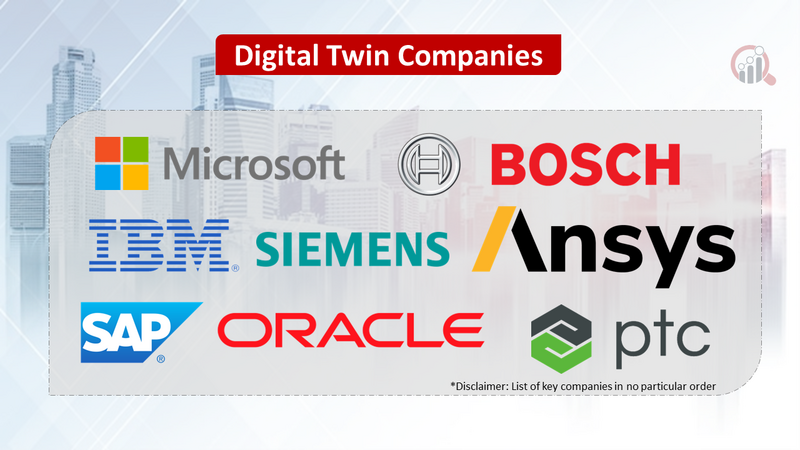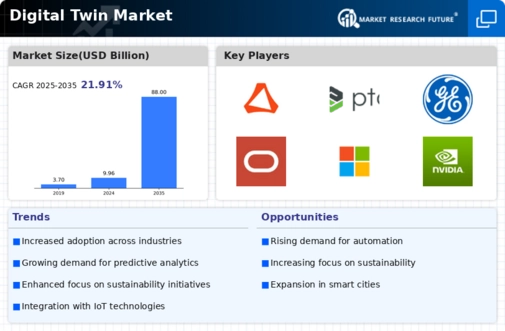Top Industry Leaders in the Digital Twin Market

Competitive Landscape of the Digital Twin Market: A Business-Focused Analysis
The Digital Twin market is witnessing rapid expansion, driven by the convergence of IoT, AI, XR, and cloud computing. This evolving landscape presents both opportunities and challenges for both established entities and new market entrants. This analysis scrutinizes the competitive environment, focusing on key players, their strategies, and factors influencing market share. It highlights emerging companies, industry news, and investment trends.
Key Players:
- General Electric (US)
- AI (US)
- IBM (US)
- Siemens AG (Germany)
- PTC (US)
- Microsoft Corporation (US)
- ANSYS (US)
- Oracle (US)
- SAP (Germany)
- Robert Bosch (Germany), among others
Strategies Adopted:
- Established players: Leverage existing customer base, expand product portfolio through acquisitions and partnerships, focus on industry-specific solutions.
- Software giants: Offer cloud-based digital twin platforms, integrate with existing software suite, target both large enterprises and SMEs.
- Emerging players: Offer innovative solutions in niche areas, focus on specific use cases, emphasize affordability and ease of use.
- Industry-specific players: Deep domain expertise, cater to specific industry regulations and standards, offer pre-built models and templates.
Factors for Market Share Analysis:
Market Share: Assess based on revenue and market capitalization.
Product Portfolio: Examine the breadth and depth of digital twin solutions.
Industry Focus: Evaluate targeting specific industries with tailored solutions.
Technology Partnerships: Consider collaborations with hardware and software vendors.
Customer Base: Analyze the number and size of clients across diverse industries.
Innovation: Review investments in R&D and the development of new features.
New and Emerging Companies:
Numerous innovative entrants are disrupting the digital twin market, often focusing on specific industry niches or offering unique value propositions challenging established players. Notable examples include:
AVEVA:
- Offers a cloud-based platform for industrial asset performance management.
- Tailors digital twin solutions specifically for the energy and process industries.
OSIsoft:
- Primarily focuses on data acquisition and management.
- Offers PI System, facilitating the integration of real-time data for building and managing digital twins.
Bosch IoT Suite:
- A cloud-based platform providing tools for connecting devices, managing data, and building digital twins.
- Applicable to various applications, including manufacturing and smart cities.
Azure Digital Twins (Microsoft):
- A cloud-based platform enabling the building and management of digital twins for physical assets.
- Facilitates real-time monitoring and analysis.
Latest Company Updates:October 2023,Research team that is headed by Tianzi Jiang at Institute of Automation of Chinese Academy of Sciences has recently outlined the chief properties and components of a ground-breaking platform known as Digital Twin Brain that will bridge the gap amid biological & AI and offer novel insights into both. Utilizing digital twin brain, the researchers can explore working mechanisms of human brain via stimulating & modulating the brain in various cognitive tasks.
Hikvision has developed a creative digital twin solution for aligning with the burgeoning need for sustainable and intelligent construction solutions. This digital twin solution allows the creation of a visual and digital replica of a building, that will facilitate the real-time monitoring of the critical performance indicators like security, climate control, and energy efficiency. Besides, it empowers efficient and swift inventions during technology outages or incidents.
WiMi Hologram, a popular global Hologram AR technology provider lately announced about its development of digital twin modelling based on the multiple data sources for building more accurate, comprehensive, & reliable digital twin models. The technology refers to integrating data from various sources to a unified model. The chief modules of integrated digital twin modelling system resting on multiple data sources comprise visualization and analysis, model deployment & real-time updating, model development & training, data integration & consolidation, data acquisition & pre-processing etc that are interdependent as well as interact with one another and jointly constitute the chief facets of integrated digital twin modelling technology.









